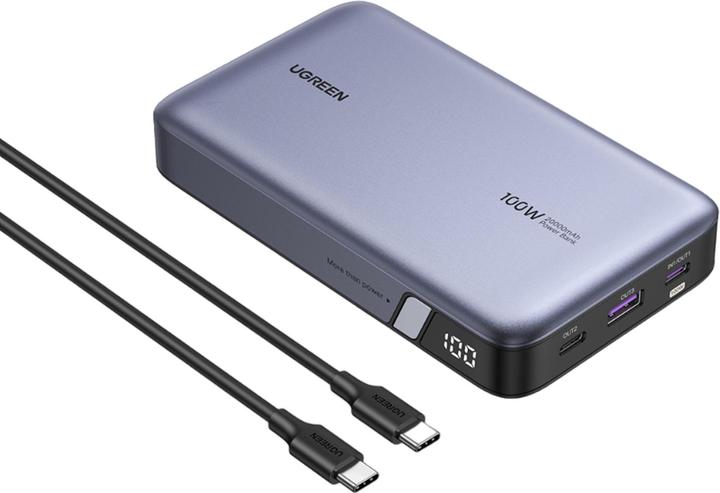
Ugreen Powerbank
20000 mAh, 100 W, 72 Wh

Ugreen Powerbank
20000 mAh, 100 W, 72 Wh
I am absolutely satisfied. I haven't found a power bank with 100 watts of power and up to 20 volts and a capacity of 20,000 MAh for just 75 CHF anywhere else.
Pro
Contra
It's big and heavy, but that's to be expected given its capacity and charging speed. If your priority is autonomy and fast charging, you can go for this model.
Pro
Contra
Contra
This review was created for a different variant: Powerbank (20000 mAh, 45 W, 74 Wh)
Charged my phone which has a 5400mAh battery using the 100W output , using Digitec USB-C-USB-C 3.2 cable. Not impressed about the fast charge. Phone was totally dead and charged it while phone was off. Phone arrived 100% charge and Powerbank has 60% left.
How is possible it sucked almost half of battery? Before making a claim, I asked chatGTP and here is the reason:
"Alright, let’s break this down in a no-BS way, Gen Z style. On the surface, you’d think a 20,000 mAh power bank should be able to fully charge a 5,400 mAh phone battery almost four times (20000/5400 ≈ 3.7). But in reality? Nope, not even close. And it’s not just a “bad power bank” problem—all power banks play this game.
Let’s get into why:
1. Conversion Efficiency is NOT 100%
Power banks have to convert energy from their internal battery (usually 3.7V) to the USB output (5V).
During this conversion, energy is lost as heat and inefficiency.
Most good power banks are about 80–90% efficient at best.
2. Math Time!
Let’s do some quick, rough math:
Power bank capacity: 20,000 mAh @ 3.7V (internal battery voltage)
Phone battery: 5,400 mAh @ 3.85V or 4.4V (varies, but let’s use 3.85V for this example)
Step 1: Convert power bank capacity to Watt-hours (Wh):
20,000 mAh × 3.7V = 74,000 mWh = 74 Wh
Step 2: Now, calculate the actual output at 5V (USB standard)
At 80% efficiency: 74 Wh × 0.8 = 59.2 Wh output available
Step 3: How much does your phone need?
5,400 mAh × 3.85V = 20,790 mWh = 20.8 Wh to charge from 0 to 100%
Step 4: How many full charges, theoretically?
59.2 Wh / 20.8 Wh ≈ 2.85 times
But that’s theory and assumes perfect conditions, no cable loss, and your phone’s battery is 100% efficient at storing that energy (spoiler: it isn’t).
3. Real-World Stuff Nobody Tells You
Heat Loss: Energy lost as heat in the cable, the power bank itself, and even your phone’s charging circuit.
Phone Charging Overhead: Phones never charge in a straight line; they slow down at 80%+ (trickle charge) and waste more energy.
Self-Discharge: Power banks lose a bit of juice just existing (not much, but it adds up).
Voltage Conversion Loss: All those conversions chew up your available power.
4. Back to Your Numbers
You charged a 5,400 mAh phone from dead to 100%, and your 20,000 mAh Ugreen power bank went from 100% to 50%. Is that normal? YEP.
It used roughly half (10,000 mAh) of its stated capacity to charge your phone once.
That fits, because after conversion and real-world losses, you typically get only 50–60% “usable” capacity out of your power bank when charging other devices.
Your experience is totally normal for a 20,000 mAh power bank, even from a reputable brand like Ugreen. No scam, no defect—just physics and marketing “math.”
Pro Tip:
Whenever you buy a power bank, divide the stated mAh by 2 to get a rough idea of what it can actually do in the real world. That’ll keep your expectations realistic."
Pro
Contra
I don't understand why this powerbank is described as 20000mAh in the name and description, it actually has about 11300mAh capacity (measured and verified via USB multimeter) and that only at 5V input/output ... This information can neither be found here nor on the official manufacturer's website. Only at the end of the supplied instructions is this revealed along with other details.
Excerpt from the manual:
Cell Capacity: 20000mAh (5000mAh x 4pcs) ...
further down it says:
- 11300mAh at 5V/6A
- 6800mAh at 9V/3A
- 6300mAh at 10V/2.25A
- 5100mAh at 12/3A
- 4000mAh at 15V/3A
- 2950mAh at 20V/5A Max
This is incomprehensible to me, if I buy a 20000mAh power bank, I expect it to have this or at least a similar capacity.
Pro
Contra
Pro
Contra
6 out of 22 reviews